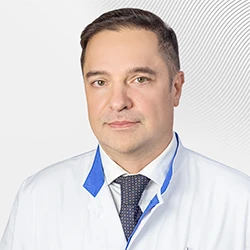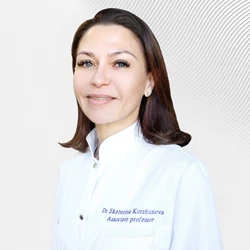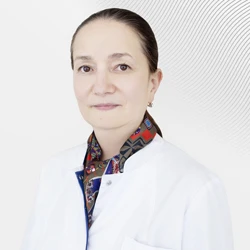Stress urinary incontinence in women
Stress urinary incontinence is a common condition that is not commonly talked about. This problem seriously impairs the quality of life and can lead to depression, limited social contacts, isolation, and other adverse consequences. Many women do not go to the doctor because they are shy or do not know that the disease is treatable.At the EMC clinic, urologists successfully work with the problem of involuntary urination, helping patients return to normal life without restrictions.
Symptoms
Stress incontinence in women is a common condition in which involuntary urination occurs during exercise, coughing, sneezing, or laughing. Symptoms can occur during any everyday situation when there is an increase in intra-abdominal pressure.
Some women experience urinary incontinence only when coughing or sneezing violently, while others experience it even when lifting a light object or walking briskly.
Causes
The causes of stress urinary incontinence in women are diverse and include both physiological and anatomical factors. Here are the most common reasons:
-
Weakening of the pelvic floor muscles that support the bladder and urethra. It can occur as a result of age-related degenerative changes, childbirth, chronic cough, obesity, or prolonged physical exertion.
-
Decreased estrogen levels, usually during menopause. It is a female sex hormone that helps maintain healthy bladder and urethral tissues.
-
Some surgical operations, including hysterectomy (removal of uterus).
Most often, women from 35 to 50 years old face the problem, although the disease can occur at any age.
It is important to understand that stress incontinence is not an inevitable part of age-related changes or a natural consequence of childbirth. There are effective treatments that can significantly improve a woman's quality of life.
Stages of development
There are different classifications for the stressful form of urinary incontinence, however, in Russian clinical practice, the classification of D. V. Kahn is usually used. It includes three stages:
-
Easy. At this stage, urine loss occurs during intense physical activity, such as running, jumping, or lifting heavy objects. These symptoms are unpleasant, but more often do not prevent a woman from leading a normal lifestyle.
-
Average. At this stage, urinary incontinence may occur with less intense physical activity, such as brisk walking, lifting light objects, or even when changing body position.
-
It's heavy. At this stage, urine loss occurs with minimal physical activity or even at rest. This can seriously affect a woman's quality of life, limiting her ability to engage in routine activities and interact with others.
Consult a doctor at the first signs of symptoms, even in the mild stage. The disease can progress, causing many inconveniences, so it is recommended to start therapy as early as possible.
Possible complications
Stress incontinence can lead to a number of complications. Most often, this is a recurring cystitis or inflammation of the bladder. In addition, the constant loss of urine can lead to irritation and inflammation of the skin in the genital area, which causes discomfort and pain.
Long-term illness can also cause psychological problems such as stress, depression, and forced isolation. Many women are self-conscious about their condition and avoid social interactions, which leads to a deterioration in their overall quality of life. It is important to remember that these complications can be prevented by timely referral to a specialist and proper treatment.
Diagnostic methods
Diagnosis of stress urinary incontinence always begins with a detailed medical history and physical examination. The doctor clarifies the nature of the symptoms, the circumstances of their occurrence, and the presence of concomitant diseases. Then the woman is assigned a series of studies:
-
Ultrasound examination (ultrasound) of the pelvic organs makes it possible to assess the condition of the bladder, ureters and kidneys, as well as to identify pathological changes in the tissues of these organs.
-
Comprehensive Urodynamic Study (CUDI). It helps to assess the function of the bladder and urethra, to determine the degree of urinary retention disorders.
-
Fibrocystoscopy is a soft cystoscope examination that allows visualization of the inner surface of the bladder and urethra. It helps to identify damage or pathology of organs that may be the cause of urinary incontinence.
Examinations help to identify the type and causes of involuntary urination. Only then will the doctor be able to prescribe adequate treatment.
Treatment methods
Treatment of NMPN in the EMC Urological Clinic is selected individually. First of all, we try to use conservative methods that do not require surgical intervention.
Conservative treatment may include:
-
drug therapy;
-
physical exercises using the biological feedback method, which helps the patient to better control the work of his body;
-
electrical stimulation of the pelvic floor muscles using special sensors installed in the rectum, vagina or urethra;
-
electromagnetic stimulation of the pelvic floor muscles using the Emsella chair (noninvasive technique).
If conservative treatment methods do not give the expected result, then the possibility of surgical intervention is considered. One of the most effective methods is sling surgery. This is the gold standard of surgical treatment for stress incontinence.
Implantation of a suburethral sling is a minimally invasive procedure. A strip of synthetic material is inserted under the urethra, which provides additional support and prevents involuntary urination.
The sling operation takes about 30 minutes, after which one day must be spent in the hospital under the supervision of specialists. A full return to normal life, including the restoration of sexual activity, usually occurs within a month after surgery.
Advantages of treatment at the EMC clinic
At the EMC Urology Clinic, we offer a comprehensive approach to the treatment of patients of all ages and genders. We have everything you need for diagnosis, therapy, surgery, rehabilitation, follow-up and prevention. Thanks to the multidisciplinary format and modern equipment, we can solve even the most difficult urological problems.
Advantages of our medical center:
-
a team of international specialists who follow the recommendations and standards of leading Western clinics;
-
the reception is conducted by urologists of various specializations – from andrologist to neurologist;
-
we involve other specialists of the center in the treatment, including internists, oncologists, endocrinologists, psychotherapists, reproductologists, gynecologists and plastic surgeons;
-
We use only original medicines for medical treatment that are approved by both international and Russian healthcare organizations.;
-
We strive to use minimally invasive and organ-preserving methods, including laparoscopic, endoscopic and robotic surgeries using the Da Vinci Si HD system.
If you experience symptoms of stress incontinence, contact the EMC Urology Clinic. We know how to solve this problem effectively and delicately. Proper treatment tactics allow most women to return to a full life without restrictions.
List of sources and references
-
Mikhelson Anna Alekseevna, Lugovykh Evgeniya Vladimirovna, Lazukina Maria Valeryevna, Varaksin Anatoly Nikolaevich, Lukyanova Kseniya Dmitrievna, Minyailo Elizaveta Maksimovna CLINICAL AND ANAMNESTIC PREDICTORS OF STRESS URINARY INCONTINENCE IN WOMEN // Gynecology. 2022. №1.
-
Petrov Yu. A., Palieva N. V., Tarasova A. Yu., Shpakova V. E. PSYCHOLOGICAL AND SEXOLOGICAL NUANCES IN WOMEN OF CHILDBEARING AGE WITH URINARY INCONTINENCE // Chief Physician of the South of Russia. 2023. №4 (90).
-
Bayashova A.S., Kausova G.K. Assessment of the quality of life of women suffering from urinary incontinence // Bulletin of KazNMU. 2019. №1.
-
Nambiar AK, Arlandis S, Bø K, Cobussen-Boekhorst H, Costantini E, de Heide M, Farag F, Groen J, Karavitakis M, Lapitan MC, Manso M, Arteaga SM, Riogh ANA, O'Connor E, Omar MI, Peyronnet B, Phé V, Sakalis VI, Sihra N, Tzelves L, van Poelgeest-Pomfret ML, van den Bos TWL, van der Vaart H, Harding CK. European Association of Urology Guidelines on the Diagnosis and Management of Female Non-neurogenic Lower Urinary Tract Symptoms. Part 1: Diagnostics, Overactive Bladder, Stress Urinary Incontinence, and Mixed Urinary Incontinence. Eur Urol. 2022 Jul;82(1):49-59. doi: 10.1016/j.eururo.2022.01.045. Epub 2022 Feb 23. PMID: 35216856.
Why the EMC
The first and only clinic in Russia, created in the image of the world's leading clinics
EMC is a multidisciplinary center offering patients a high level of medical services and a personalized approach
Worldwide recognition and awards
 Learn more
Learn more
Worldwide recognition and awards
 Certificates and licenses
Certificates and licenses
Make an appointment for a consultation
Specify your contacts and we will contact you to clarify the details
Reviews
and new products of the EMC



.webp)





.webp)


.webp)
